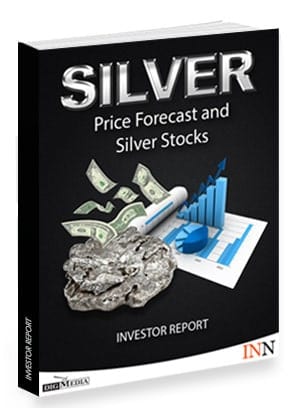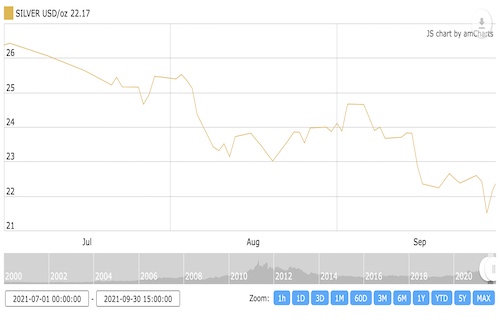
Update on silver price: Inflation still to move price
Throughout the quarter, the theme of the effects of inflation on silver prices and the future actions by the Fed was a constant theme.
David H. Smith (an analyst at Morgan Report) spoke in mid-July about the growing disconnect between the Fed's statements and what we see.
He told 11 Ways to Make Money that it seemed like they are less knowledgeable about Main Street. They claim inflation is too high right now. However, it's temporary and many things will be taken care of once the pipeline fills.
The analyst pointed out that the indicators that indicate inflation is more persistent and deep-rooted than temporary, such as the rising price of food, rent increases, real estate prices, and the service sector.
"The backlog, shipping and all of these things are creating what i believe is a perfect storm of inflation that will be much higher that most people who are investing today."
Watch Smith dive into the silver market.
Smith warned of possible stagflation. This is characterized by economic stagnation, inflation, and a drop in gross domestic product. This term was popularized in the 1970s and 1980s, when inflation rose to 14 percent. It then declined to 3.5 percent in the mid-80s.
Smith stated that "We paid more to get just about everything, and at the end it caused one the biggest boons of history in gold and silver," Smith added. "And, of course, very high rates of interest, so that gold and silver can thrive in an environment with high interest rates."
The silver price soared by 260 percent to US$35 in January 1980, an increase of 260 percent over June 1979.
Smith sees some optimism in the mining sector as a result the inflationary tone. "I believe we are in for times that will be more productive for those in the metals or miners than was the case in 2000, which had very strong returns."
Update on silver prices: Supply to outstrip demand
As economies around the world return to normalcy in the coming months, the consolidation of industrial demand will likely be temporary. The US$1 trillion allocated for infrastructure spending could act as a catalyst for the precious metallic, which is used in electric vehicle manufacturing and solar paneling.
Forbes reports that "Silver's conductivity, corrosion resistance, and conductivity make it necessary to conductors, electrodes, and nearly every electrical connection within an EV uses it. In fact, 55 million ounces are used annually by the auto industry."
Another driver of demand is the rise in connectivity and electrical applications.
According to the September report of The Silver Institute on Silver Demand, annual demand for this metal will grow from 2020's 249 million ounces to 246 millions ounces by 2025. This is a 10% increase.
Cru International compiled the report. It states that each of these connectivity applications will require many and varied sensors, communication and tracking devices, as well as a variety of monitoring, tracking, and communication devices. Many of these devices will use silver in their electrical contacts and semiconductors. The infrastructure that supports this connectivity transition, such the 5G network or the "internet of everything", will also contribute to an increase in demand for silver.
This steady demand will increase supply disparities. Smith explained that this will happen as the grade of existing mines deteriorates and as current mines age.
He said that "(Copper- and silver miners) are) having to dig more ore, and they're getting less out of it." "There haven’t been any major discoveries in recent years and this will continue as we see the crunch (in) the electric vehicle market moving forward."
Silver market players are concerned about the quality and longevity of copper mines. Approximately 70% of silver production annually is dependent on base metals mining, especially copper mining.
The rise in nationalistic sentiments, and geopolitical tensions has also created more jurisdictional risk that could hinder new production.
Smith stated that there won't be many deposits because it takes a long time for them to reach the production stage. It can take between 15 and 20 years to go from the pre-feasibility phase to get to that stage. He also mentioned that US$2-US$3 trillion dollars is required to get into a productive mode.
"So those things will be coming on line less often, because they are located in high-tax and poor governance areas that are now questionable. Over the next 10-15 years, there will be fewer copper deposits than people think.
Smith believes that silver prices should rise for these reasons.
Update on silver prices: Values break out of Q3 slump
The September 29th, white metal values fell to a low of US$21.52 for the year. This is a 15.93 percent decrease from January.
The gap in the ratio of gold to silver grew as prices fell. It reached an all-time high of 80.17 on September 30th, a 16.11-point increase over the February low of 64.26.

Silver price performance Q3 2021. Chart via Kitco.
However, the September consolidation served as a launching point for the metal’s Q4 performance with prices trending higher throughout October.
Widespread inflation, mixed with the Fed’s announcement that pandemic aid is ending, worked to move silver more in line with its precious metal sister.
“What tends to happen is when a major resistance area in silver is broken and it tends to lag a gold move then the pyrotechnics get started,” Smith explained. “And a lot of people will look at further resistance levels and they’ll try to take profits when those levels are hit.”
Still, as he noted, it’s hard to tell if the white metal will reach the US$50 level.
“Silver likes to slice through those levels so predicting (a price move) is really difficult,” he said.
While the US$50 threshold may be hard to forecast, Chris Marchese, chief mining analyst at GoldSeek and SilverSeek, sees the white metal breaching the US$30 range in the near term.
“I’m still very optimistic about silver,” he said during a September interview. “Once it does cross that US$30 to US$31 level I believe it will be testing all-time highs within six to eight months after that, maybe less.”
Listen to Marchese discuss mining stocks above.
For Marchese, the move to US$30 needs to happen in a meaningful way.
“Ideally (it happens) on a monthly, maybe quarterly close, on good strong sustained volume, not just (an) intraday hit (where it goes to) US$30.10 then comes back down,” Marchese said.
“It can’t be like that, it needs to at least close the week, month and quarter above US$30 and once that happens I think all systems are go for US$50 to US$60 silver.”
Securities Disclosure: I, Georgia Williams, hold no direct investment interest in any company mentioned in this article.
Editorial Disclosure: The 11 Ways to Make Money does not guarantee the accuracy or thoroughness of the information reported in the interviews it conducts. The opinions expressed in these interviews do not reflect the opinions of the 11 Ways to Make Money and do not constitute investment advice. All readers are encouraged to perform their own due diligence.
 Make Money OnlineForexInvestingBitcoinVideosFinancePrivacy PolicyTerms And Conditions
Make Money OnlineForexInvestingBitcoinVideosFinancePrivacy PolicyTerms And Conditions
